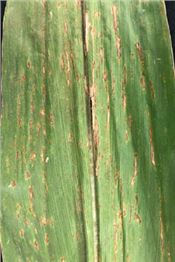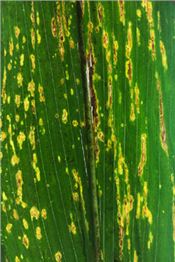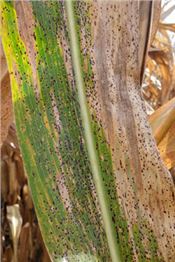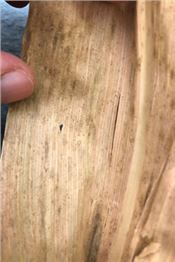|
Emerging Diseases In Missouri Corn Production
DR. KAITLYN BISSONNETTE
COLUMBIA, MO.
Corn producers in many Midwestern states have been faced with two newly emerging diseases affecting production in past five years: bacterial leaf streak and tar spot on corn. In some cases, serious economic losses have been observed in areas of the Midwest as a result of infection by the pathogens responsible for these diseases. In Missouri, both bacterial leaf streak and tar spot were detected in Missouri corn fields in 2019 and are diseases to monitor in the 2020 season. Below are some quick facts about each disease and tips on how to scout.
Bacterial leaf streak (BLS)
Xanthomonas vasicula subsp. vasiculorum
BLS of corn was confirmed in samples from 2 counties in west central (Ray Co) and north central (Chariton Co) Missouri in July of 2019. This pathogen was first detected in the United States in 2014/2015 in Nebraska and has spread through surrounding states relatively quickly. With this disease relatively new to the United States, information is still being gathered about differences amongst hybrids and management strategies. This disease is likely to show up following windy, wet weather as most bacterial diseases require wounds and water to infect. Missouri is late to the game with many of our neighboring states (Kansas, Nebraska, Iowa, and Illinois) have already reported the presence of BLS for several years. BLS is often confused with gray leaf spot. If you are observing inadequate control of gray leaf spot in your field, check for the possibility of BLS. Detecting areas where BLS is present is critical because the pathogen overwinters on residues at the soil surface and on weedy hosts. Here are some BLS scouting tips:
Scouting tips
WHERE IN THE CANOPY?
Can occur anywhere in the canopy.
WHEN IN THE SEASON?
Occurs at any time, but generally follows high winds, hail damage, or other inclement weather which allows for wounds to occur and water to splash the bacteria into the wounds on the corn leaves.
SYMPTOMS
Water soaking, long necrotic lesions with irregular margins (Figure 1) and a yellow halo which is most obvious when leaves are back lit (Figure 2).
SIGNS
Bacterial streaming – often this must be observed under a microscope, so it is best to send a sample in for testing.
CURRENT DISTRIBUTION IN MISSOURI
Currently, BLS has only been positively confirmed in 2 counties in Missouri but is suspected to be present in at least 3 more counties. If BLS is suspected, please submit a sample to University of Missouri Extension or contact Kaitlyn Bissonnette (bissonnettek@missouri.edu).SURVIVAL
Overwinters on residues and on weedy hosts.
More information can be found in this Crop Protection Network publication:
https://crop-protection-network.s3.amazonaws.com/publications/cpn-2008-bacterial-leaf-streak.pdf
Tar spot
Phyllachora maydis
I n the fall of 2019, tar spot of corn was confirmed in 3 counties in northeast Missouri (Scotland, Lewis, and Clark counties). This fungal disease has rapidly spread throughout the Midwest since it first appeared in Indiana and Illinois in 2015. With little known about this disease or the pathogens that cause it, researchers are working to come up with management solutions. In areas where tar spot is well established, differences have been observed among hybrids, fungicides, and cultural practices as to control this disease. Missouri is on the developing front of tar spot, so disease levels are currently low, making the focus scouting and detection of new counties. This is especially important as this pathogen overwinters on corn residue in the field. Often, tar spot can be confused with dirt on leaves, insect frass (excrement), or southern rust late in the season as the pustules turn black from a change in spore phases. Here are some tips for what to look for when scouting for tar spot:
Scouting tips
WHERE IN THE CANOPY?
Can occur anywhere in the canopy, but generally begins in the lower canopy in fields with a history of disease.
WHEN IN THE SEASON?
Generally begins in the late reproductive growth stages. In Missouri, scouting should begin in Mid-late August through harvest. Tar spot can affect both healthy green tissue (Figure 3) and senescing tissue (Figure 4) as we approach harvest.
SYMPTOMS
Occasionally, there can be a tan "fish-eye" or tan diamond-shaped lesion surrounding the black dots (stroma) on the leaves. In severe cases, plants will begin to prematurely senesce with yield loss becoming significant.
SIGNS
Black, raised dots on leaves called stroma. Can be a single stroma on a single leaf (Figure 4) or multiple stroma covering the leaves, husks, and ears (Figure 3). Present on green leaves or senescing leaves. Stroma do not rub off with a fingernail and have not broken through the leaf surface like the pustules of southern rust.
CURRENT DISTRIBUTION IN MISSOURI
Currently, tar spot has been confirmed in 3 counties in northeast Missouri. If tar spot is suspected, please submit a sample to University of Missouri Extension or contact Kaitlyn Bissonnette (bissonnettek@missouri.edu). Updates on county confirmations can be found at corn.ipmpipe.org
SURVIVAL
Overwinters on residues at the soil surface and possibly on weedy hosts.
More information can be found in this Crop Protection Network publication:
https://crop-protection-network.s3.amazonaws.com/publications/tar-spot-file . ∆
DR. KAITLYN BISSONNETTE: Department of plant pathology, University of Missouri

Figure 1. Characteristic symptoms of bacterial leaf streak showing water soaked, long necrotic lesions with irregular margins.
Photo by K. Bissonnette

Figure 2. A corn leaf effected by the bacterial leaf streak pathogen when backlit. Note the yellow halos around the long,
necrotic lesions. The yellow halo is the result of the bacteria invading the cells around infection points on the leaf and spreading through the plant.
Photo by K. Bissonnette

Figure 3. Stroma of tar spot covering a leaf with both green tissue and brown senescing tissue. Multiple diseases can occur together with tar spot.
These black, raised dots are the stroma of the tar spot pathogen which overwinters on residues at the soil surface.
Photo by K. Wise

Figure 4. A single stroma of the tar spot pathogen on a brown senescing leaf. At low levels, tar spot can be difficult to detect as it is only a single spot on a single leaf.
Photo by K. Bissonnette
|
|